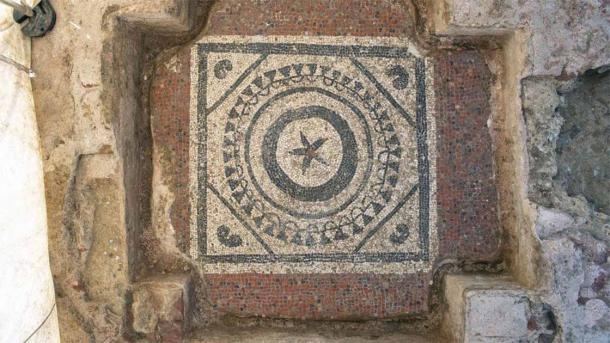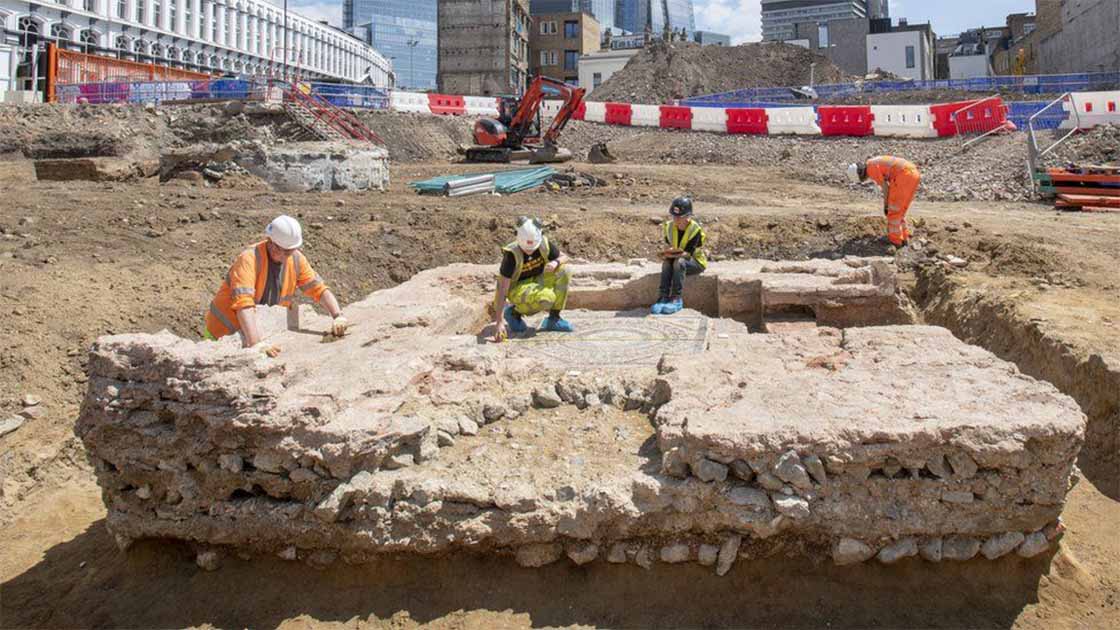“Completely Unique” 2,000-Year-Old Roman Mausoleum Unearthed Near London Bridge
Archaeologists have made an extraordinary discovery at the Liberty of Southwark development site in London—a “completely unique” Roman mausoleum of unparalleled preservation, now considered the most intact structure of its kind ever unearthed in Britain. This 2,000-year-old Roman funeral monument, recently unveiled by the Museum of London Archaeology (MOLA), contains a striking mosaic in the middle of the floor surrounded by a raised platform, where the burials would have been placed.
Roman London: A Treasure Trove of Artifacts
Antonietta Lerz, senior archaeologist at Museum of London Archaeology, said the find was:
“a microcosm for the changing fortunes of Roman London – from the early phase of the site where London expands and the area has lavishly decorated Roman buildings, all the way through to the later Roman period when the settlement shrinks and it becomes a more quiet space where people remember their dead. It provides a fascinating window into the living conditions and lifestyle in this part of the city in the Roman period.”

A mosaic formed the floor of the original mausoleum chamber found at Liberty of Southwark excavation site, London. (MOLA)
Located in close proximity to the bustling Borough Market and London Bridge station, the excavation site has proven to be a treasure trove of ancient artifacts. Just last year, archaeologists uncovered the largest Roman mosaics found in London in over half a century at the same location. Now, attention has turned to the mausoleum, which has greatly excited researchers, reports The Guardian. Roman London remains one of the most highly excavated Roman sites of anywhere in the world.
A Mausoleum Par Excellence
The walls and interior floors have remarkably withstood the test of time, presenting a solid, intact structure. At the center of this ancient tomb lies a visually striking mosaic, adorned with intricate patterns and designs. Surrounding the mosaic is a raised platform that served as the resting place for the deceased. Even the lowest entrance steps have survived, much to the delight of the archaeology team.
The mausoleum was likely used by the wealthier members of society, in the form of a family tomb or even a burial ‘club’. In such an arrangement, members would have paid a monthly fee ultimately to be buried inside.
The passage of time and human intervention have caused parts of the tomb to weather, particularly during the medieval period. The remains offer some clues about the former grandeur of the structure, and there are two accompanying stories in this regard.
Evidence suggests that it underwent significant modifications during its existence, including the discovery of a second mosaic directly beneath the first. The two mosaics share similar motifs, featuring a central flower surrounded by concentric circles, indicative of the exquisite craftsmanship of the era.

The lower mosaic of the mausoleum, revealed directly beneath its later counterpart. (MOLA)
A Wealth of Accompanying Artifacts
While the mausoleum did not yield coffins or human remains, the excavation team unearthed a wealth of other artifacts, reports CBS News. These include 100 coins, spanning various periods which give some insight about the monetary systems and trade networks of the time. In addition, metal scraps, fragments of pottery vessels, and remnants of roofing tiles were discovered, hinting at the architectural techniques and decorative elements employed in constructing the mausoleum.
Beyond the mausoleum itself, the surrounding area yielded further archaeological treasures. More than 80 Roman burials were uncovered, offering another glimpse into the funerary customs and burial practices of the period. Among these burial sites, researchers uncovered a diverse array of artifacts, including ornate copper bracelets, delicate glass beads, more Roman coins. Remarkably, even a bone comb was found amidst the ancient remains.
MOLA has hailed this discovery as an extraordinary rarity, with the level of preservation surpassing any previously found Roman mausoleum in Britain. The meticulous archaeological investigations were conducted on behalf of Landsec, Transport for London (TfL), and Southwark Council.
As researchers continue to analyze and interpret the findings, the Roman mausoleum stands as a powerful testament to the enduring legacy of the Romans in London. As Southwark council cabinet member Catherine Rose said, “The rediscovery of this Roman mausoleum and mosaics is a testament to the rich tapestry of our past.”
Top image: The Roman mausoleum found in London. It features a mosaic surrounded by a raised platform, which archaeologists believe was for burials Source: MOLA
By Sahir Pandey
References
Davies, C. 2023. ‘Astonishing’ Roman tomb unearthed near London Bridge station. Available at: https://www.theguardian.com/uk-news/2023/jun/13/incredibly-rare-roman-tomb-unearthed-near-london-bridge-station.
Dorrell, C. 2023. ‘Completely unique’: Roman mausoleum unearthed near Borough Market and London Bridge. Available at: https://www.cityam.com/completely-unique-roman-mausoleum-unearthed-near-borough-market-and-london-bridge/.
Lyons, E. 2023. Rare Roman mausoleum unearthed at London development site. Available at: https://www.cbsnews.com/news/roman-mausoleum-unearthed-at-london-development-site/.
Sundaravelu, A. 2023. 2,000-year-old twist in the London Bridge tiles. Available at: https://metro.co.uk/2023/06/13/remains-of-a-roman-tomb-unearthed-near-london-bridge-station-18943599/?ico=just-in_home_just-in.

















